Last season was Leicester City Women’s first as a fully professional club, having been taken over by men’s team owners King Power International, and they rewarded that financial backing by securing promotion to the WSL for the first time in their history. During the summer, it was announced that they would play the majority of this season’s home games at the King Power Stadium, with Manchester United Women the first to travel to the newly-promoted side. They came expecting a difficult afternoon against a Leicester team hoping to secure their first points of the season, but this tactical analysis will demonstrate how the visitors’ clever attacking play helped them to defeat the home side, as well as detailing the positives and negatives of Leicester’s performance.
Lineups

Leicester City Women made four changes from last weekend’s loss at Aston Villa Women, opting to deploy a 4-3-3 formation and not the 3-4-1-2 they used at Walsall’s Banks’ Stadium. Defender Abbie McManus moved to the bench, whilst midfielders Sophie Barker and Shannon O’Brien and new Wales forward Hannah Cain missed out completely, with full-backs Sophie Howard and Jemma Purfield, Nigeria centre-back Ashleigh Plumptre and forward Lachante Paul all starting. Striker Natasha Flint moved to a midfield role, and former Everton Women defender Georgia Brougham partnered Plumptre in the middle of the defence, with the latter captaining her hometown club in Barker’s absence.
Manchester United Women also made changes, despite winning the curtain-raiser against Reading Women. Former Chelsea Women centre-back Maria Thorisdottir and fellow Norway international, midfielder Vilde Boe Risa, both started on the bench, with Millie Turner partnering former Manchester City Women defender Aoife Mannion in central defence, whilst Netherlands midfielder Jackie Groenen came into the midfield. Captain Katie Zelem was in her usual deep-lying role, whilst England’s Ella Toone continued to operate as a false nine in attack.
Manchester United Women’s attacking play
Manchester United Women are still in transition under former Birmingham City Women and Orlando Pride boss Marc Skinner, but we have already noticed some things that he has changed tactically since replacing Casey Stoney.
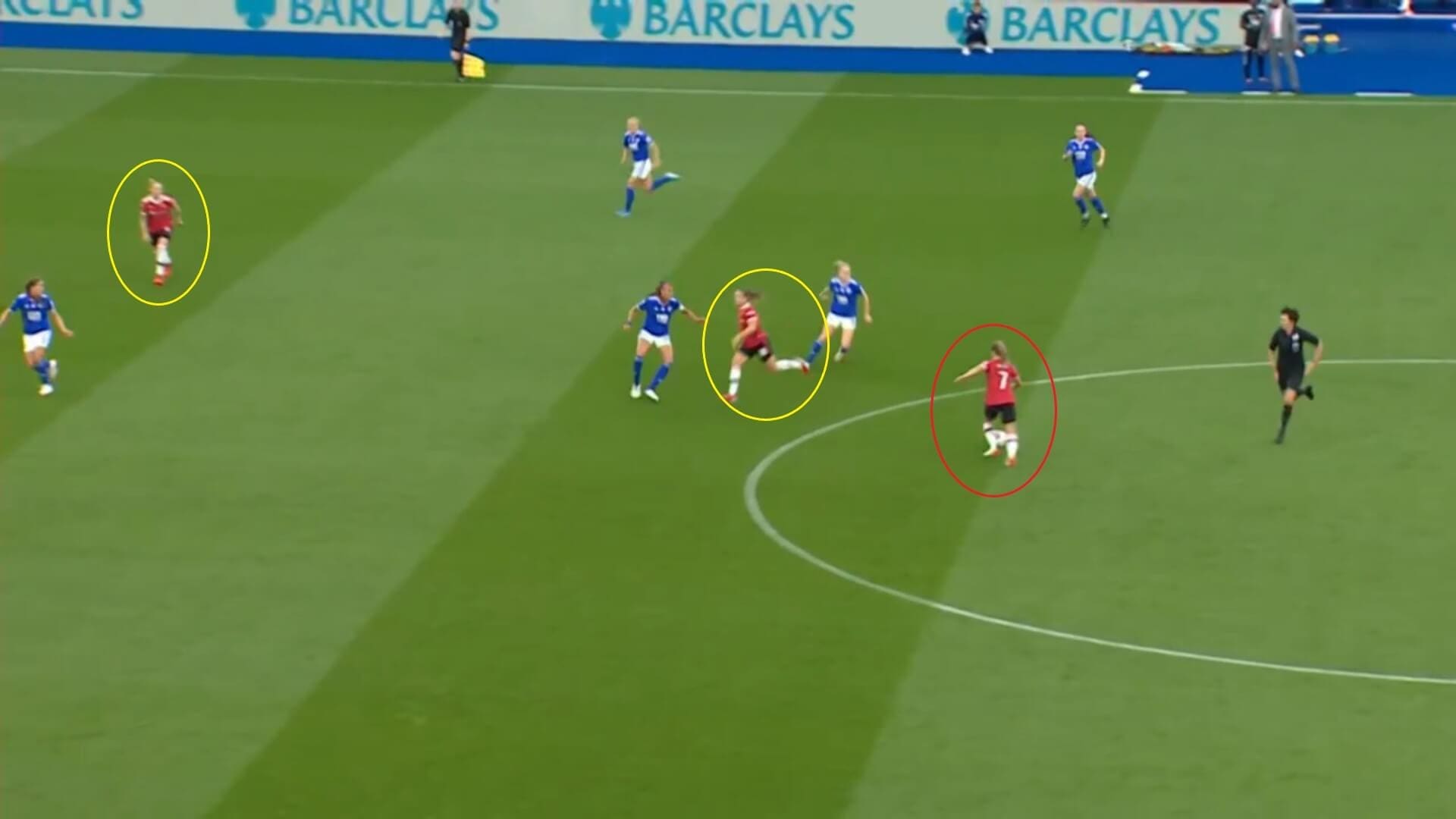
The major alteration has been Ella Toone’s role in the team. Last season, she was an attacking midfielder who played in the pivot role, creating opportunities for the likes of Christen Press and Tobin Heath ahead of her. Skinner’s Orlando also played with this role at times, so it was expected that Toone would continue in that position. However, he instead sees her as a centre forward, hoping that it will give the team more fluidity in the final third.
To explain, this image shows how Toone, in the red circle, has dropped back to receive the ball in the midfield. This is not unusual, as it is her natural position, but the key is that it allows others to get ahead of her and create passing options. From the defenders’ point of view, they don’t know who will make runs and when, so it is harder to defend against. As well as coming back, Toone also got behind the defence, playing as a striker would, and her constant positional changes were the reason that she was the most dangerous player on the pitch, with Leicester City Women unable to deal with her at the best of times.
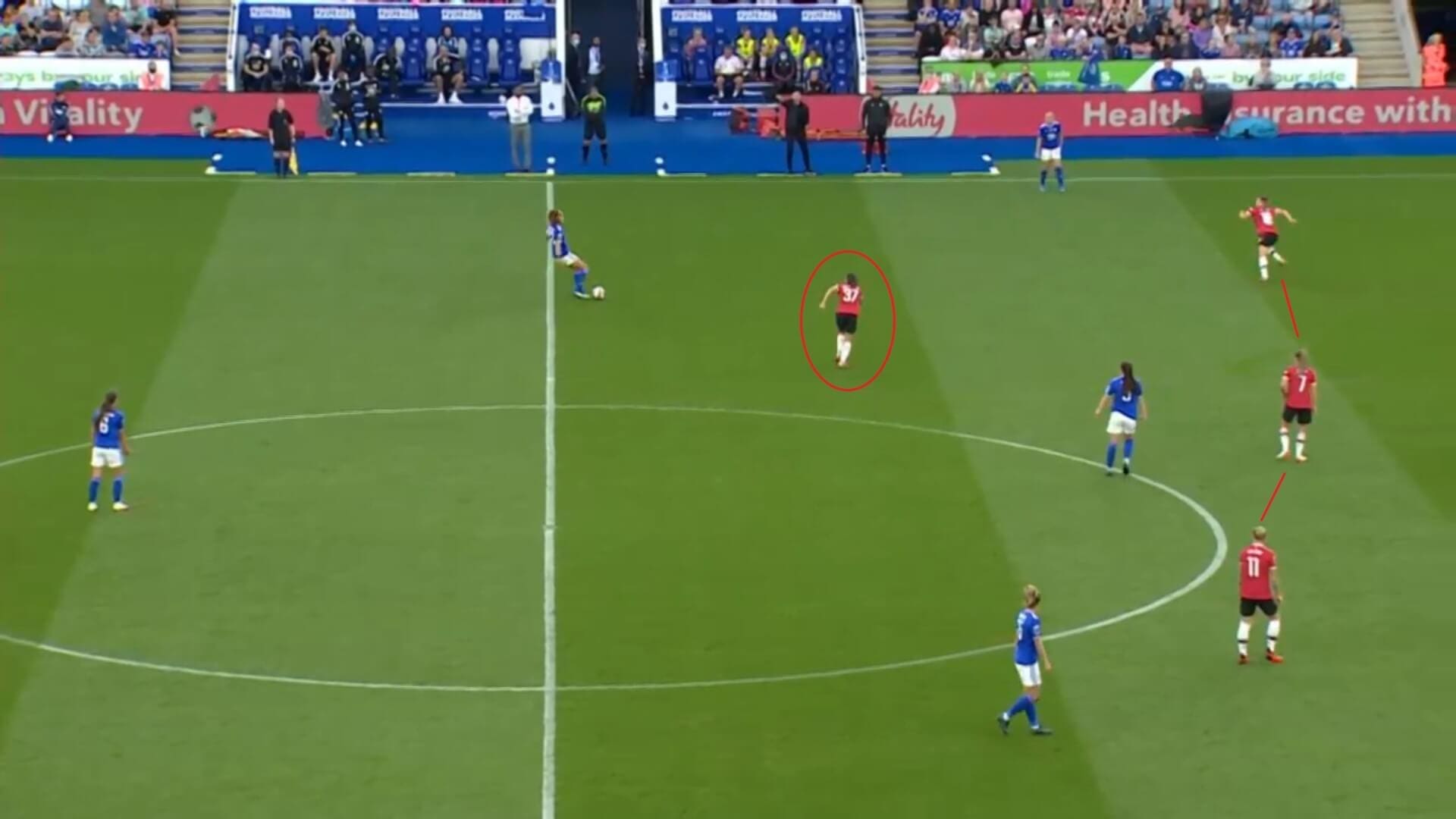
As a result of Toone’s free role, the other Manchester United players needed to continuously adapt their own positions, with this image showing how wingers Kirsty Hanson and Leah Galton are in their usual roles, but Lucy Staniforth has gone forward to take Toone’s place ahead of them.
Last season, their attack was more rigid, with players given a role and tending to stick to that area of the field. Marc Skinner, however, liked his Orlando players to pass and move, always looking for space to run into, and this is clearly something he has introduced to Manchester United. When we consider this tactical change, it is not hard to see why they have scored five goals in their two league games this season, and have proved difficult for both Reading and Leicester to defend against.
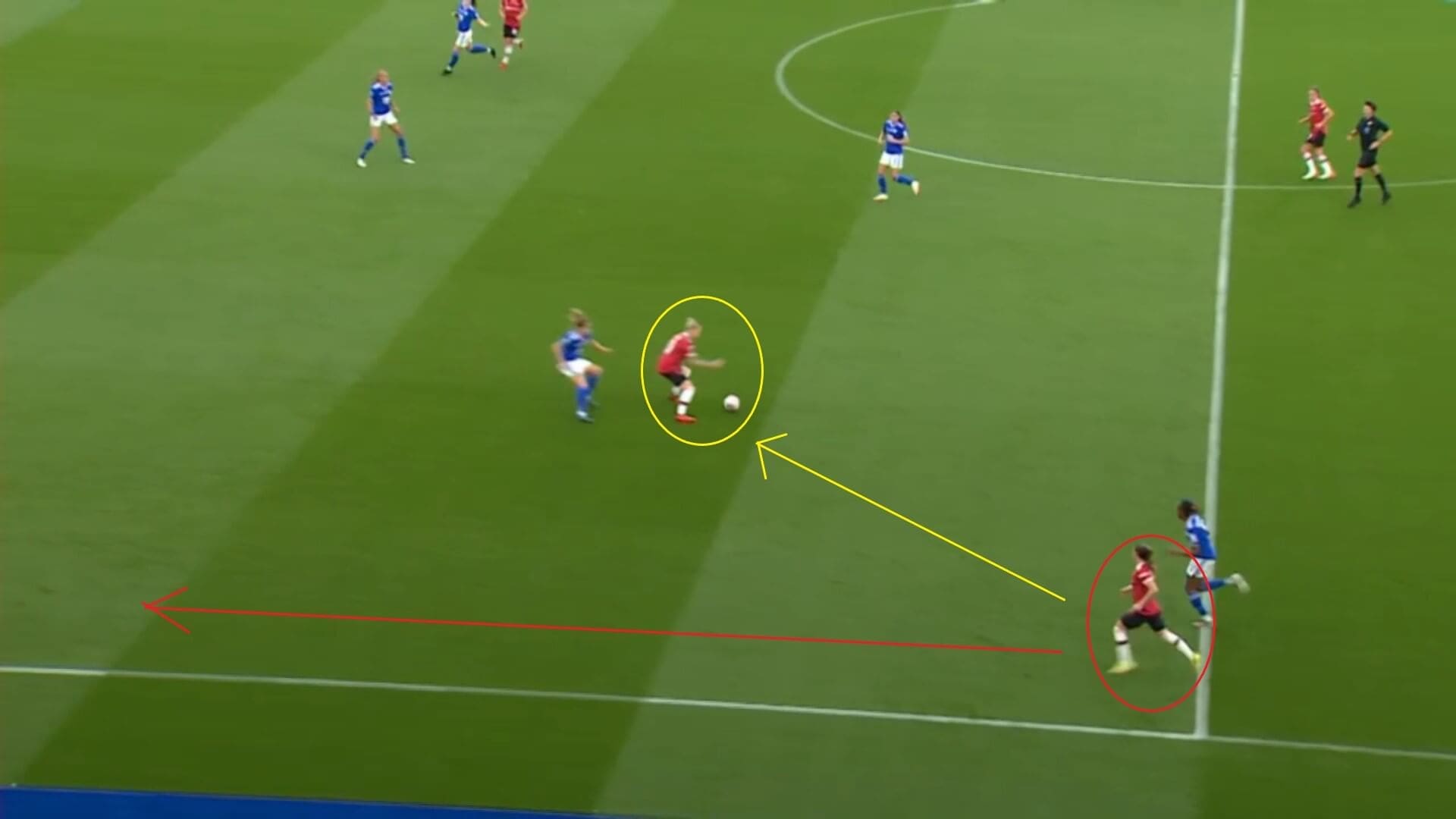
Another key feature of Skinner’s tactics at Orlando was to dominate the wings, and this image shows Spain full-back Ona Batlle pushing up the field to support the attack. The yellow arrow indicates her pass to Galton, before she runs up the wing to receive the ball back from the former Bayern Munich Frauen player, as illustrated by the red arrow.
This link-up play was a constant part of Manchester United’s game, and 2-v-1 situations against the Leicester defenders were the result. Batlle was particularly important with these, with Hannah Blundell not getting up the right side of the pitch as often. The Spain player’s control of the wing meant that Hanson and Galton could cut inside the pitch much more, increasing Manchester United’s central threat. Therefore, we can see why Manchester United’s attacking play and intent was an essential reason for them winning this game.
Leicester City Women’s positives
Leicester City Women may have now picked up back-to-back losses, but that doesn’t mean that they have a poor tactical approach to matches. In fact, it is quite the opposite, with Jonathan Morgan’s side possessing a good playing style, usually revolving around pressing and working hard for each other.

It took a while for Leicester to get into this game, with Manchester United Women having plenty of time to control the ball and look for the next pass. However, once the home side began to press with the intent that Morgan wants them to have, the visitors needed to play quicker, and risked losing the ball on a few occasions. Here, forward Paige Bailey-Gayle is closing down Millie Turner, and, once the ball was passed, another attacker would get forward to do the same thing.
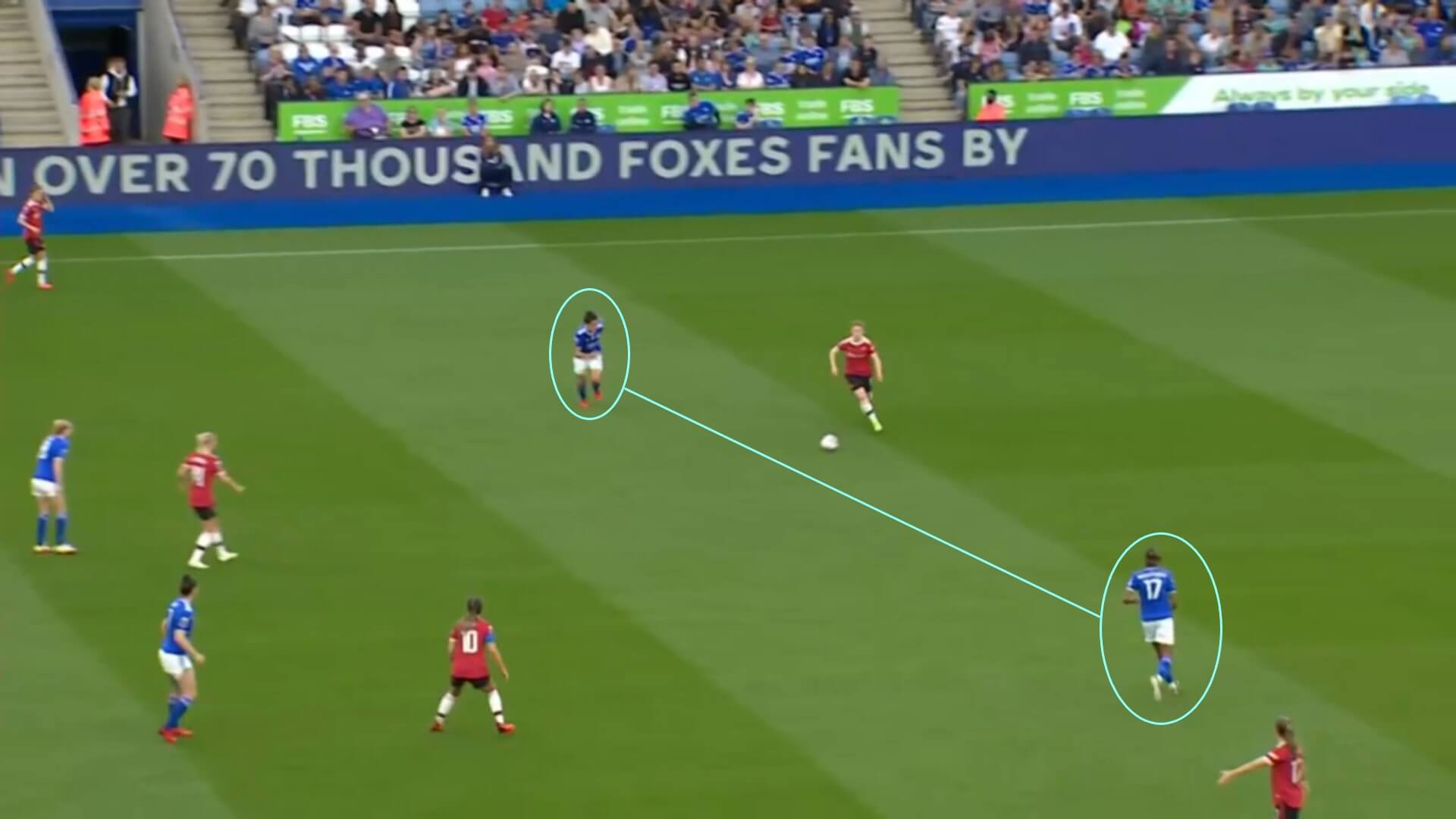
However, Leicester’s problem was that they didn’t press together, and this came from their starting formation. Against Aston Villa, Natasha Flint and Jessica Sigsworth operated as a front two, but former Manchester United striker Sigsworth led the line on her own this time. However, it wasn’t working, with Manchester United playing around the press, and Morgan pushed Bailey-Gayle into a more advanced role to try and address this issue.
This positive attacking change was further strengthened by the decision to introduce Charlie Devlin in the final stages of the first half, with Paige Bailey-Gayle withdrawn. As Devlin is an attacking midfielder, the substitution allowed Flint to form a front two with Sigsworth, going back to the tactics they looked more comfortable with last weekend. In effect, it seemed as if Leicester had tried something new but realised that it wasn’t working, and their quick changes here shows how good they will be tactically this season, with the adaptability to fix problems an important characteristic to have in the WSL.
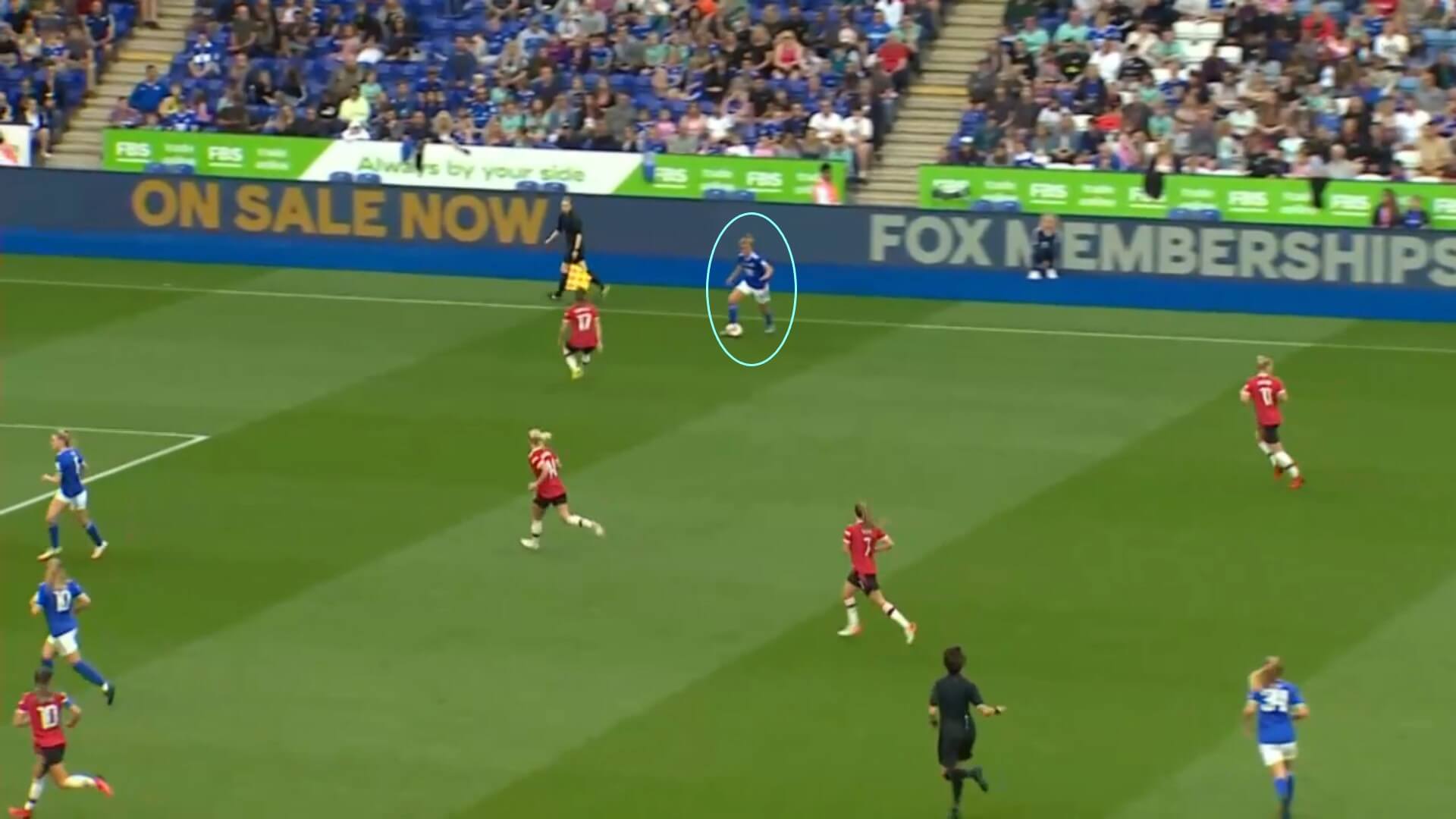
One of Leicester’s main first half issues was that their full-backs, Sophie Howard and Jemma Purfield, were unable to advance up the pitch, due to Manchester United’s already-analysed final third play. However, this was something else that the home side looked to change in the second half, with Dutch full-back Esmee de Graaf, a major part of Leicester’s Championship title success last season, replacing Howard. She instantly got forward and tried to create opportunities for her teammates in the box, but Manchester United were alive to this and got out to limit her space, as this image shows.
However, because Leicester had a more attacking player in the wide channels, they posed more of a threat in the second half, and Manchester United had to work hard to keep players like midfielder Molly Pike out, with the former Everton player having two good efforts saved by Manchester United’s England goalkeeper Mary Earps.
Leicester City Women’s things to improve
However, despite these positives, there were things that Leicester City Women need to work on, as we will now look at.
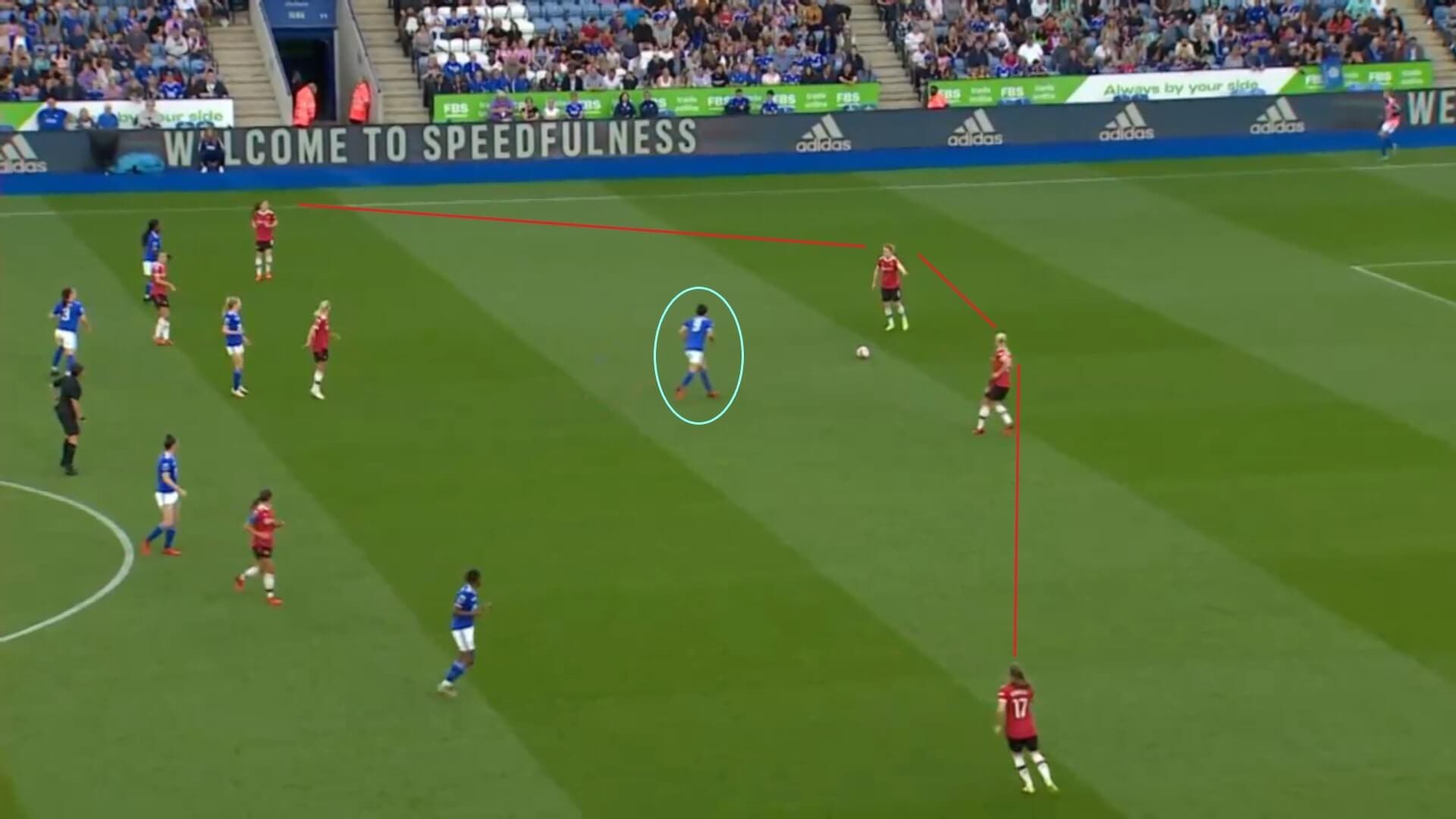
We have already seen how Leicester’s first half pressing was good, but only one player went at a time, with the others staying back, as this image shows. As a result, Manchester United Women found it easy to play around them, using their wide defensive setup to transfer the ball from side to side and keep it out of Leicester’s reach. When it came to playing the ball forwards, Manchester United were again helped by Leicester leaving gaps open between individual players, allowing the visitors to play simple ground passes through them and into the midfielders, never having to work too hard in their transitional play.
Closing the gaps is something Leicester need to fix urgently, because the top teams in the WSL play simple football, always looking to punish mistakes made by their opponents. If the gaps had been closed up here, then Manchester United would have been forced to play more aerial balls from their own third, giving Leicester a chance to get underneath them and clear their lines, so this is something for them to think about ahead of their next game.
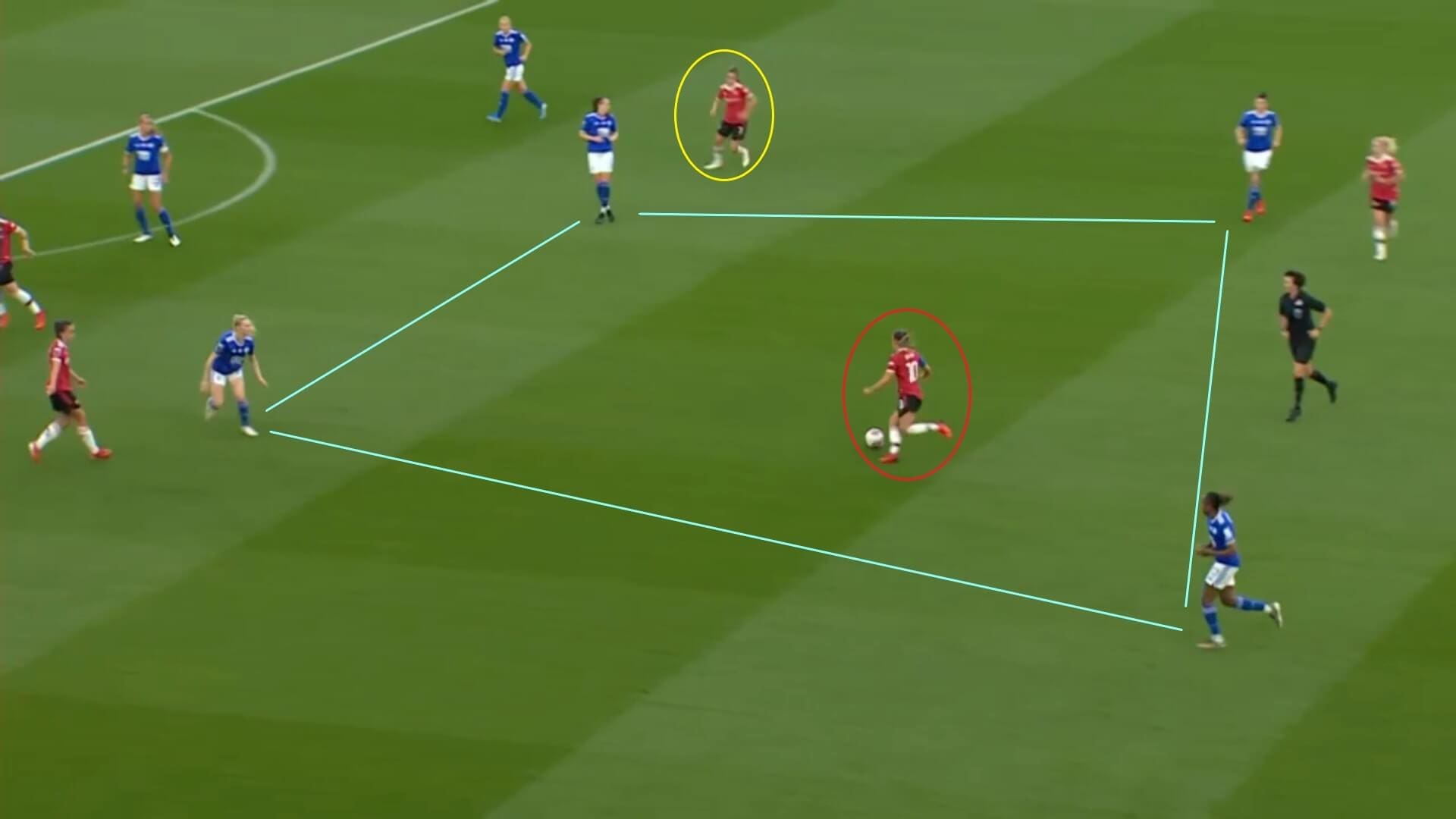
Leicester left spaces open in other ways too, with Manchester United constantly allowed to dribble the ball for long distances under no pressure from their opponents, decreasing the distance it needed to travel to reach the attackers. This image shows the build-up to Ella Toone’s opening goal, with the visiting attackers pinning the Leicester defenders back, but the midfielders and forwards have given Katie Zelem so much space to play in. Bearing in mind that the Manchester United captain operates as a deep-lying playmaker, she was able to dribble the ball into this area under no pressure, before sliding the ball across to Toone, in the yellow circle, to score.
If the players on the edge of this square had closed Zelem down, she would have been forced to release the ball earlier than she did. Toone may not have been the best option at that time, so the goal may not have come about in the same manner as it did. Therefore, whilst Toone’s goal was a stunning long-range strike, Leicester could have prevented it, and this shows how little mistakes can be costly in this league.
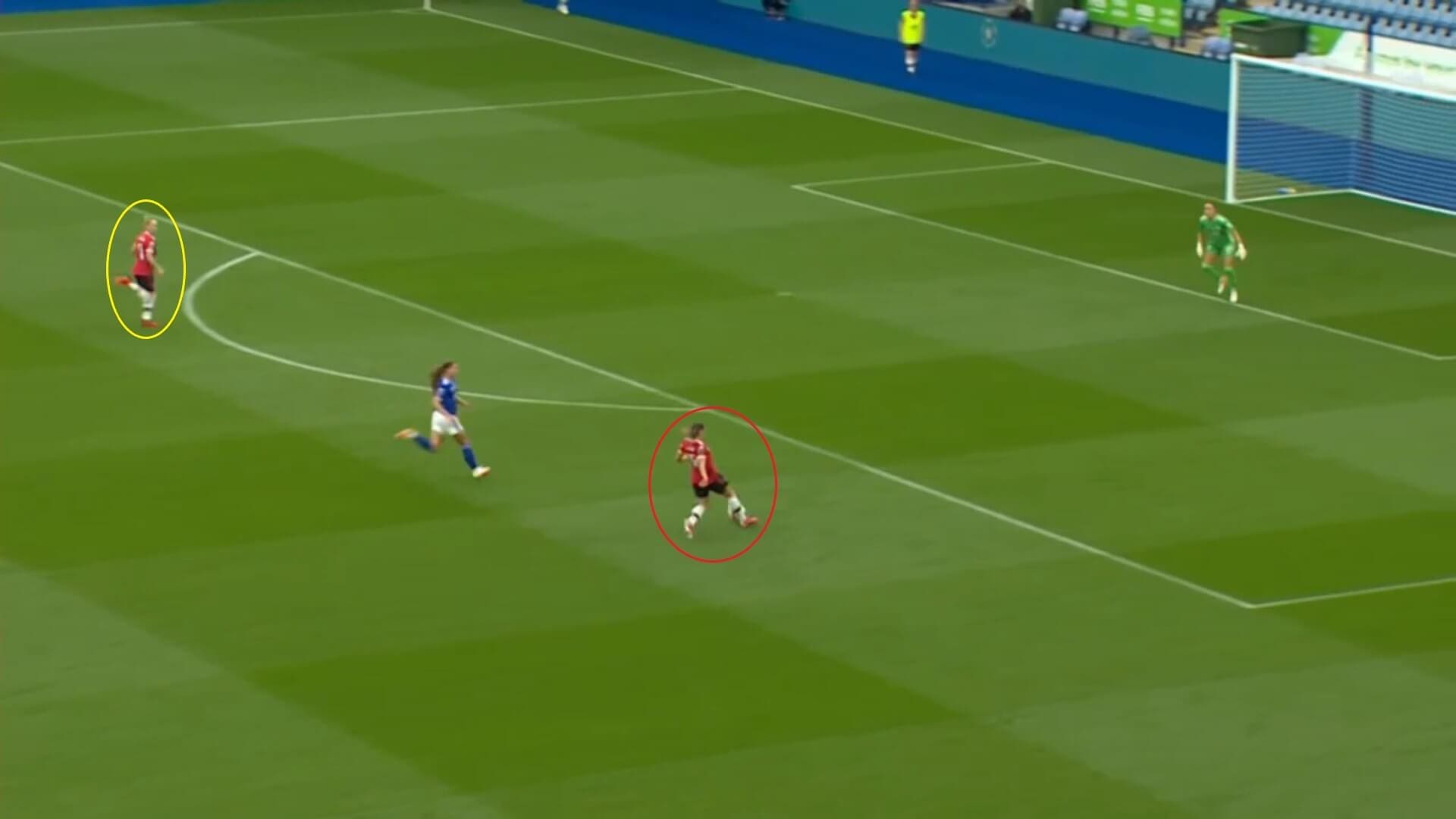
The other major problem that Leicester had was in defence. Throughout the game, their defenders tended to advance towards the halfway line, but then couldn’t get back quickly enough to cover the space behind them when Manchester United had possession. The visitors were alive to the space being left open behind the Leicester players, and continually targeted it with long-range aerial passes for the forwards to chase down.
Having a high backline was a key part of Manchester United’s tactics under Casey Stoney, and it caught them out on numerous occasions, so they knew how to punish Leicester for doing the same thing. This image shows Kirsty Hanson and Leah Galton in behind the Leicester defence, with Scotland international Hanson setting up Galton to shoot at goal. Whilst the effort was wasted on this occasion, this is another aspect of the game that Leicester need to improve on.
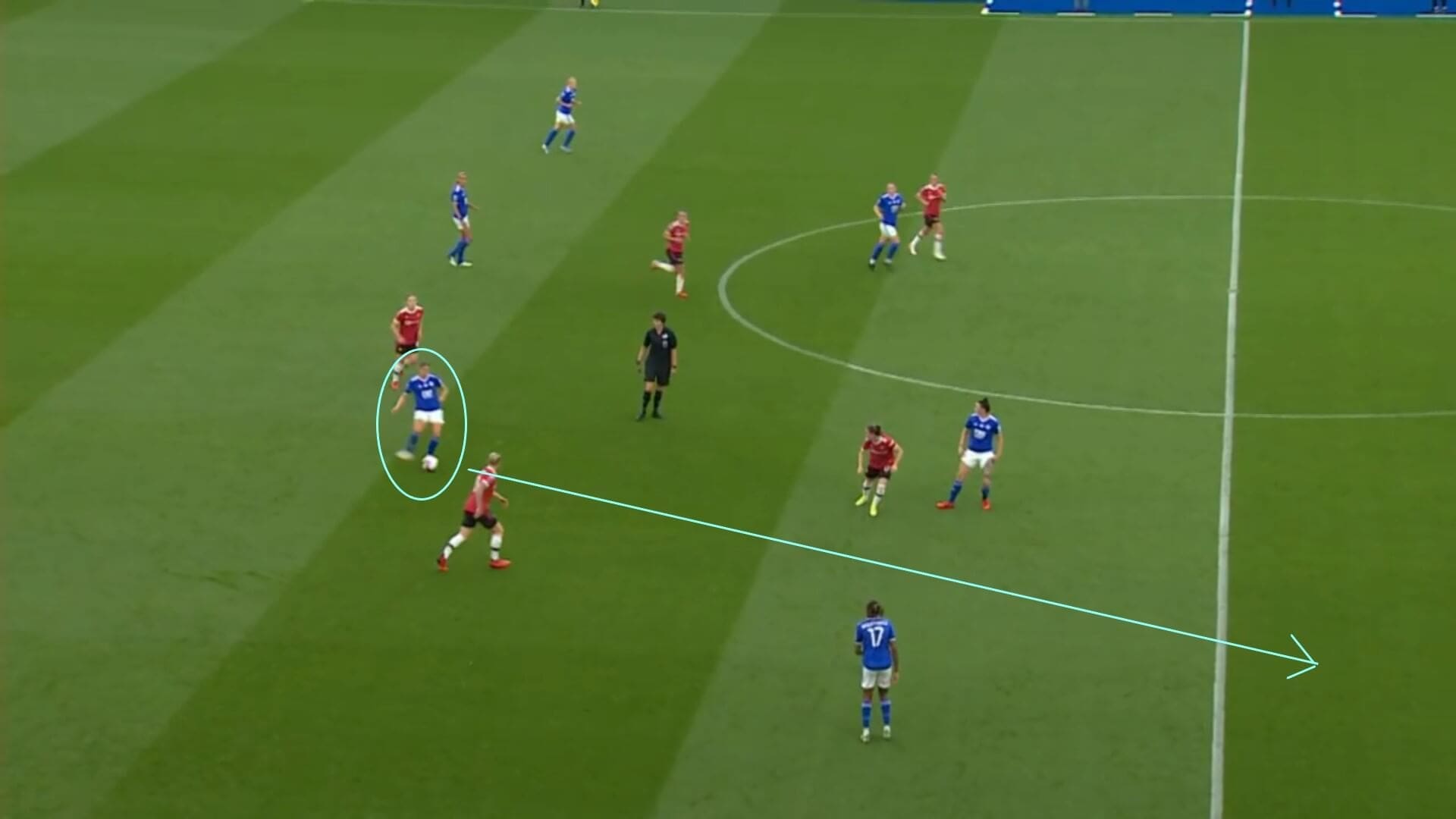
Leicester also had a general lack of quality on the ball at times, especially when passing it around. This image shows a pass from Georgia Brougham going between Natasha Flint and Paige Bailey-Gayle, hit too hard for either of them to reach. Therefore, from an opportunity for Leicester to launch an attack from the back, the ball has been given away and Manchester United have been able to reapply the pressure on them. At times, this came down to poor communication between players, so is easily fixed, but it is still something that Jonathan Morgan needs to address.
Conclusion
In conclusion, this tactical analysis has shown Manchester United Women’s excellent attacking play, which came as a result of the changes Marc Skinner has made since his appointment during the off-season, although they were undoubtedly helped by Leicester City Women’s mistakes. He has said that he wants his team to play exciting football, and they have certainly started the season in that fashion.
It does sound from this analysis that Leicester have a long way to go, but that is not the case. We need to remember that this was only their second-ever WSL game, and they are still adjusting to life in the top flight. The fact that Jonathan Morgan identified what was hindering them in the first half is a positive in itself, and having different tactical options in the squad is also hugely important. There will be lessons Leicester have learnt from this game, but there were also plenty of positives that they can take too.
This weekend is the first international break of the season, so Leicester’s next game is a trip to West Ham the following weekend. Manchester United, meanwhile, are back at home, with defending champions Chelsea visiting them earlier on the same day.





Comments